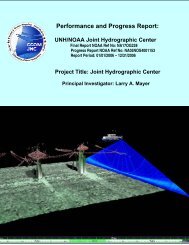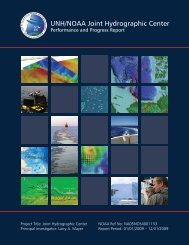Vessel Tracking Using the Automatic Identification System (AIS ...
Vessel Tracking Using the Automatic Identification System (AIS ...
Vessel Tracking Using the Automatic Identification System (AIS ...
Create successful ePaper yourself
Turn your PDF publications into a flip-book with our unique Google optimized e-Paper software.
Schwehr 2011: Presented at US Hydro, Tampa Fl 8<br />
Figure 8. Response vessel positions from N<strong>AIS</strong> as released<br />
to <strong>the</strong> public through GeoPlatform.<br />
N<strong>AIS</strong> Public Release<br />
On May 31, I was informed that <strong>the</strong> NOAA Web Operations<br />
Center (WOC) was working to clone portions<br />
of ERMA for <strong>the</strong> public through a project called Geo-<br />
Platform (Figure 8). The original intent of ERMA, as<br />
viewed by Rob Braswell and myself, was that anyone, ei<strong>the</strong>r<br />
inside or outside of NOAA, should be able to clone<br />
most of <strong>the</strong> ERMA system for an emergency response<br />
without requiring our help. It is very encouraging that<br />
GeoPlatform went live on June 10, 2010 using much<br />
of ERMA without anyone from <strong>the</strong> GeoPlatform group<br />
having to contact Rob Braswell or me.<br />
However, <strong>the</strong> ERMA system is still not as simple as<br />
we would prefer. There was a lot of collaboration between<br />
<strong>the</strong> WOC team, NOAA ERMA contractors and<br />
<strong>the</strong> UNH RCC required to setup GeoPlatform. Additionally,<br />
many of <strong>the</strong> data layers in ERMA are unfortunately<br />
restricted to responders only, or cannot be<br />
released to <strong>the</strong> public due to NOAA rules forbidding<br />
release of data without proper metadata.<br />
Early in <strong>the</strong> DWH response, <strong>the</strong>re were multiple requests<br />
for N<strong>AIS</strong> data in ERMA to be released to <strong>the</strong><br />
public in real-time. The communities both inside and<br />
outside of <strong>the</strong> USCG are split on whe<strong>the</strong>r or not <strong>the</strong><br />
USCG should publicly release N<strong>AIS</strong>-collected data and,<br />
if N<strong>AIS</strong> is released, how much data should be made public<br />
and with what time delay, if any. The USCG has an<br />
interim release policy (USCG, 2010) that prohibits any<br />
public release of N<strong>AIS</strong> during <strong>the</strong> first 12 hours after receipt<br />
of a message. On June 11, after much discussion<br />
at <strong>the</strong> USCG, Admirals Thad Allen and James Watson,<br />
along with Roger Parsons, decided to mandate realtime<br />
public display of response vessel locations from<br />
Outage<br />
Figure 9. 56 days of Nagios tracking of <strong>the</strong> ERMA<br />
feed at UNH. Nagios examining <strong>the</strong> number of unique<br />
ship MMSI’s received in a 10 minute sliding window,<br />
and emails a notice when it detects <strong>the</strong> count dropping<br />
below a threshold.<br />
<strong>AIS</strong> position reports. The GeoPlatform project, which<br />
was already accessible by <strong>the</strong> general public, allowed<br />
for <strong>the</strong> display any vessel that is classified as involved<br />
in <strong>the</strong> DWH response. ERMA, with <strong>the</strong> full N<strong>AIS</strong> feed,<br />
was reserved for response personnel only. ERMA forwarded<br />
<strong>the</strong> response vessel positions to GeoPlatform every<br />
2 two minutes. This open access to vessel locations<br />
greatly aided communication between responders and<br />
<strong>the</strong> public trying to understand events occurring in <strong>the</strong><br />
Gulf of Mexico. Additionally, this allowed responders<br />
even better access to critical ship position information<br />
without having to worry about au<strong>the</strong>nticating with <strong>the</strong><br />
ERMA web application.<br />
Reliability and fault recovery<br />
As <strong>the</strong> complexity of <strong>the</strong> systems grew at CCOM/JHC,<br />
we reached <strong>the</strong> point where it was essential to have an<br />
automated system (e.g. Nagios, OpenNMS, or Antelope)<br />
provide continuous integrity monitoring of servers,<br />
software and data feeds. We began monitoring <strong>the</strong><br />
ERMA N<strong>AIS</strong> processing server in early 2010 using Nagios.<br />
This only included checks of <strong>the</strong> basic machine<br />
health. During <strong>the</strong> DWH incident, <strong>the</strong> ERMA N<strong>AIS</strong><br />
feed up time became a critical issue with many people<br />
depending on <strong>the</strong> ERMA vessel display. Jordan Chadwick<br />
and I set up a Simple Network Management Protocol<br />
(SNMP) check of <strong>the</strong> vessel database in Nagios.<br />
Our initial check watches <strong>the</strong> number of unique MMSI<br />
seen in <strong>the</strong> last 10 minutes (Figure 9). We can control<br />
<strong>the</strong> minimum number of ships ship before a warning<br />
is issued. This allows us to catch a general failure<br />
anywhere in <strong>the</strong> system before it substantially impacts<br />
users of ERMA. The web display is only updated every<br />
two minutes for ship motion and during <strong>the</strong> response




